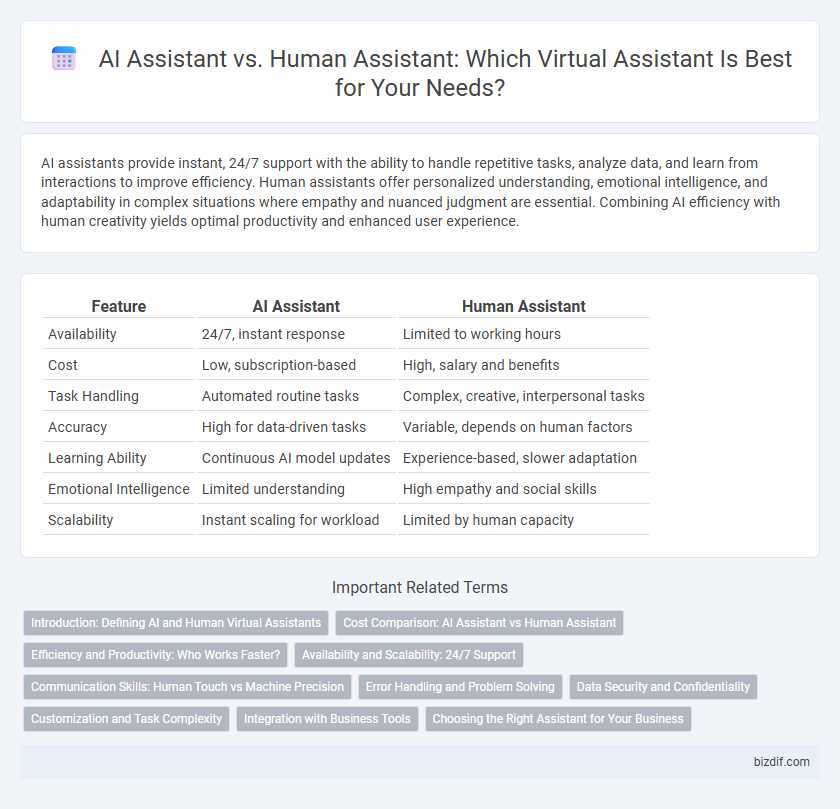AI assistants provide instant, 24/7 support with the ability to handle repetitive tasks, analyze data, and learn from interactions to improve efficiency. Human assistants offer personalized understanding, emotional intelligence, and adaptability in complex situations where empathy and nuanced judgment are essential. Combining AI efficiency with human creativity yields optimal productivity and enhanced user experience.
Table of Comparison
| Feature | AI Assistant | Human Assistant |
|---|---|---|
| Availability | 24/7, instant response | Limited to working hours |
| Cost | Low, subscription-based | High, salary and benefits |
| Task Handling | Automated routine tasks | Complex, creative, interpersonal tasks |
| Accuracy | High for data-driven tasks | Variable, depends on human factors |
| Learning Ability | Continuous AI model updates | Experience-based, slower adaptation |
| Emotional Intelligence | Limited understanding | High empathy and social skills |
| Scalability | Instant scaling for workload | Limited by human capacity |
Introduction: Defining AI and Human Virtual Assistants
AI assistants utilize machine learning algorithms and natural language processing to perform tasks and respond to queries autonomously, offering scalable and consistent support. Human virtual assistants provide personalized services with emotional intelligence, adaptability, and complex problem-solving skills that AI currently cannot fully replicate. Defining these roles highlights the AI assistant's strength in automation and data handling, contrasted with the human assistant's nuanced understanding and interpersonal interactions.
Cost Comparison: AI Assistant vs Human Assistant
AI assistants offer significant cost savings compared to human assistants by eliminating expenses such as salaries, benefits, and office space. The operational costs of AI assistants are largely limited to software subscriptions and occasional maintenance, making them highly scalable and budget-friendly for businesses. Human assistants, while providing personalized and adaptable support, incur ongoing costs that can substantially impact long-term financial planning.
Efficiency and Productivity: Who Works Faster?
AI assistants process tasks and data at speeds significantly faster than human assistants due to machine learning algorithms and automation capabilities. Human assistants excel in complex decision-making and interpersonal communication but cannot match AI's capacity for rapid multitasking and 24/7 availability. Productivity gains are maximized when AI handles repetitive, data-driven tasks while humans focus on strategic and creative work.
Availability and Scalability: 24/7 Support
AI assistants provide unmatched 24/7 availability, ensuring continuous support without fatigue or downtime. Human assistants offer personalized interaction but are limited by work hours and capacity constraints. Scalability favors AI assistants as they can seamlessly handle increasing workloads without compromising response times or quality.
Communication Skills: Human Touch vs Machine Precision
Human assistants excel in communication skills by interpreting emotions, understanding nuances, and providing empathetic responses that foster trust and rapport. AI assistants leverage machine precision to deliver consistent, data-driven communication, quickly processing vast information to offer accurate and relevant responses without fatigue. Combining the human touch with AI's efficiency creates a balanced approach that enhances overall user interaction quality.
Error Handling and Problem Solving
AI assistants excel in error handling by quickly analyzing large datasets and identifying patterns to prevent recurring issues, ensuring consistent performance without fatigue. Human assistants offer nuanced problem-solving capabilities, leveraging emotional intelligence and contextual understanding to address complex or ambiguous challenges effectively. Combining AI precision with human empathy creates a robust approach to managing errors and resolving problems in dynamic environments.
Data Security and Confidentiality
AI assistants employ advanced encryption protocols and real-time threat detection to ensure data security, minimizing the risk of breaches. Human assistants, while capable of exercising discretion, may unintentionally expose sensitive information due to human error or insider threats. Implementing AI-powered security measures enhances confidentiality by reducing vulnerabilities inherent in manual data handling processes.
Customization and Task Complexity
AI assistants offer high customization through machine learning algorithms that adapt to user preferences and automate routine tasks efficiently. Human assistants excel in managing complex, nuanced tasks requiring emotional intelligence and context-based decision-making. Combining AI's data-driven precision with human creativity ensures optimal performance in diverse work environments.
Integration with Business Tools
AI assistants seamlessly integrate with business tools such as CRM systems, email platforms, and project management software through APIs, enabling real-time data synchronization and task automation. Human assistants, while adaptable and capable of handling nuanced communication, often rely on manual input and lack the same level of instant connectivity across multiple digital platforms. This streamlined technological integration allows AI assistants to enhance productivity and reduce operational bottlenecks in complex business environments.
Choosing the Right Assistant for Your Business
AI assistants offer 24/7 availability, rapid data processing, and cost efficiency, making them ideal for handling repetitive tasks and customer inquiries. Human assistants provide personalized interactions, emotional intelligence, and adaptability, which are crucial for complex problem-solving and nuanced communication. Evaluating your business needs, such as volume of routine tasks versus demand for human touch, guides the decision between AI and human assistance.
AI assistant vs Human assistant Infographic

 bizdif.com
bizdif.com